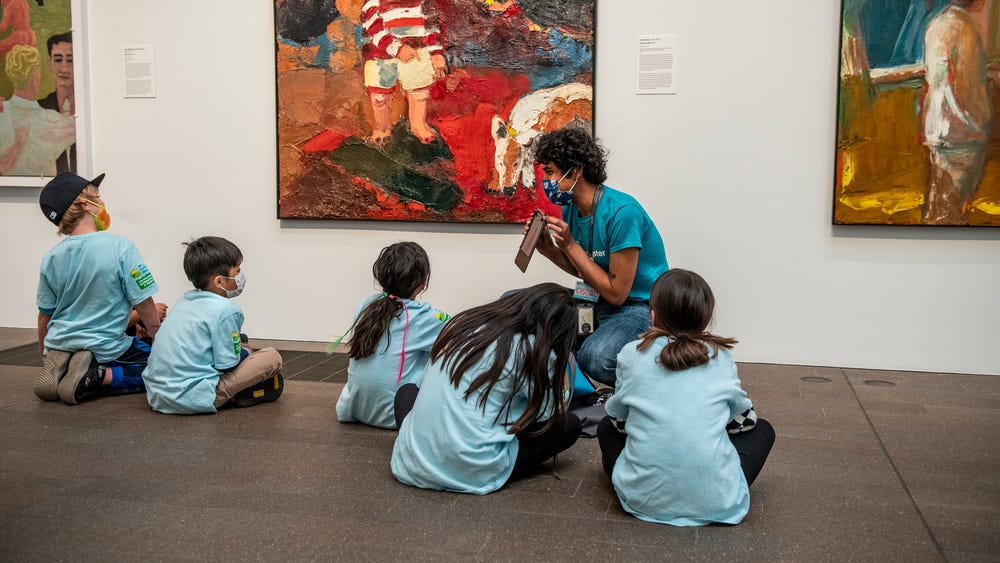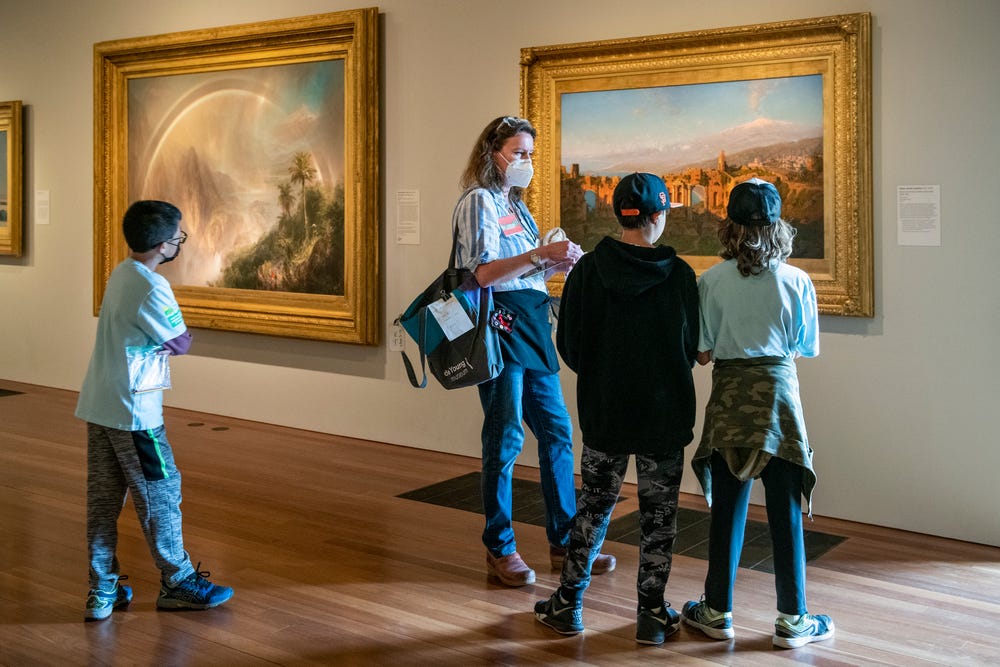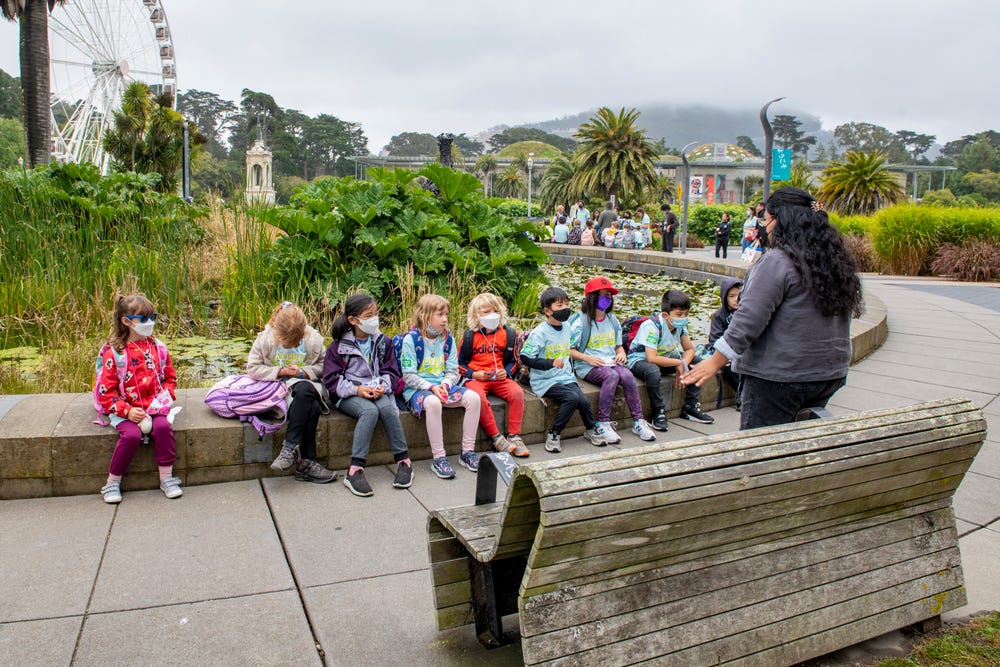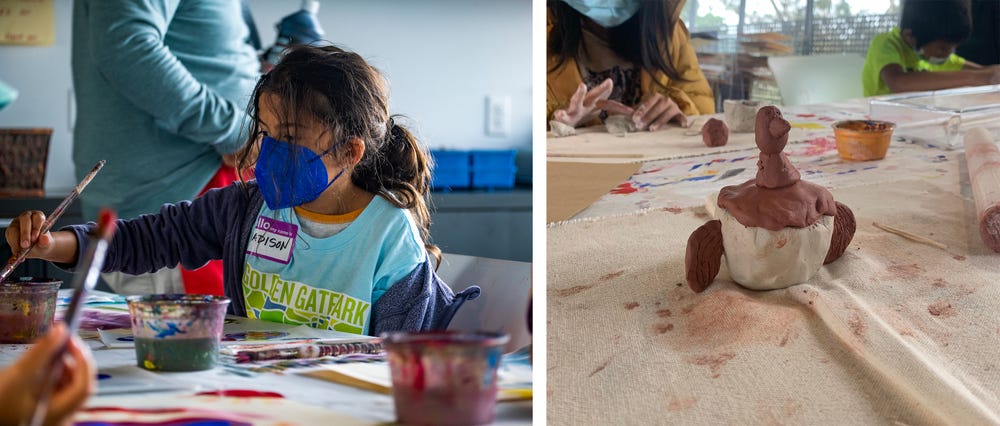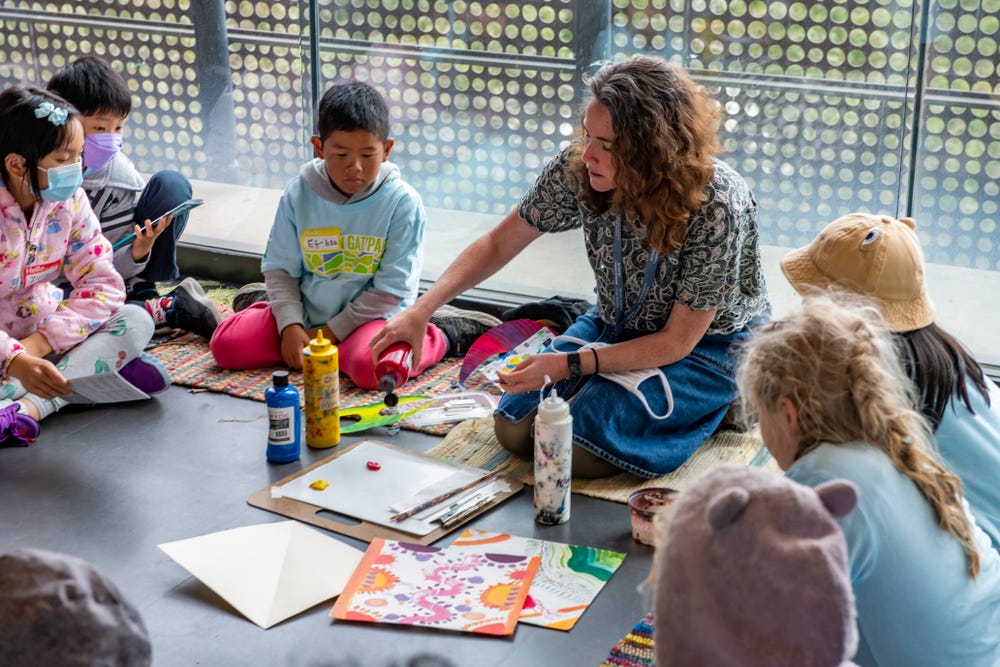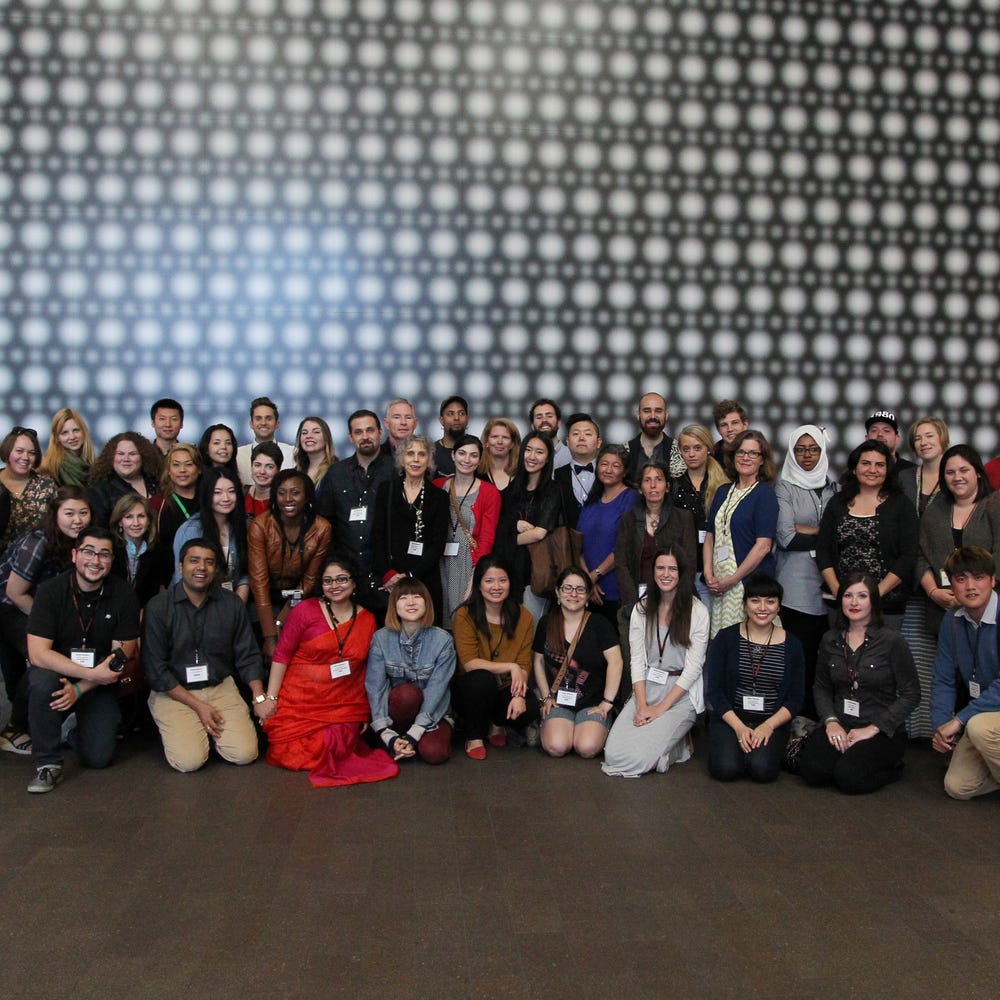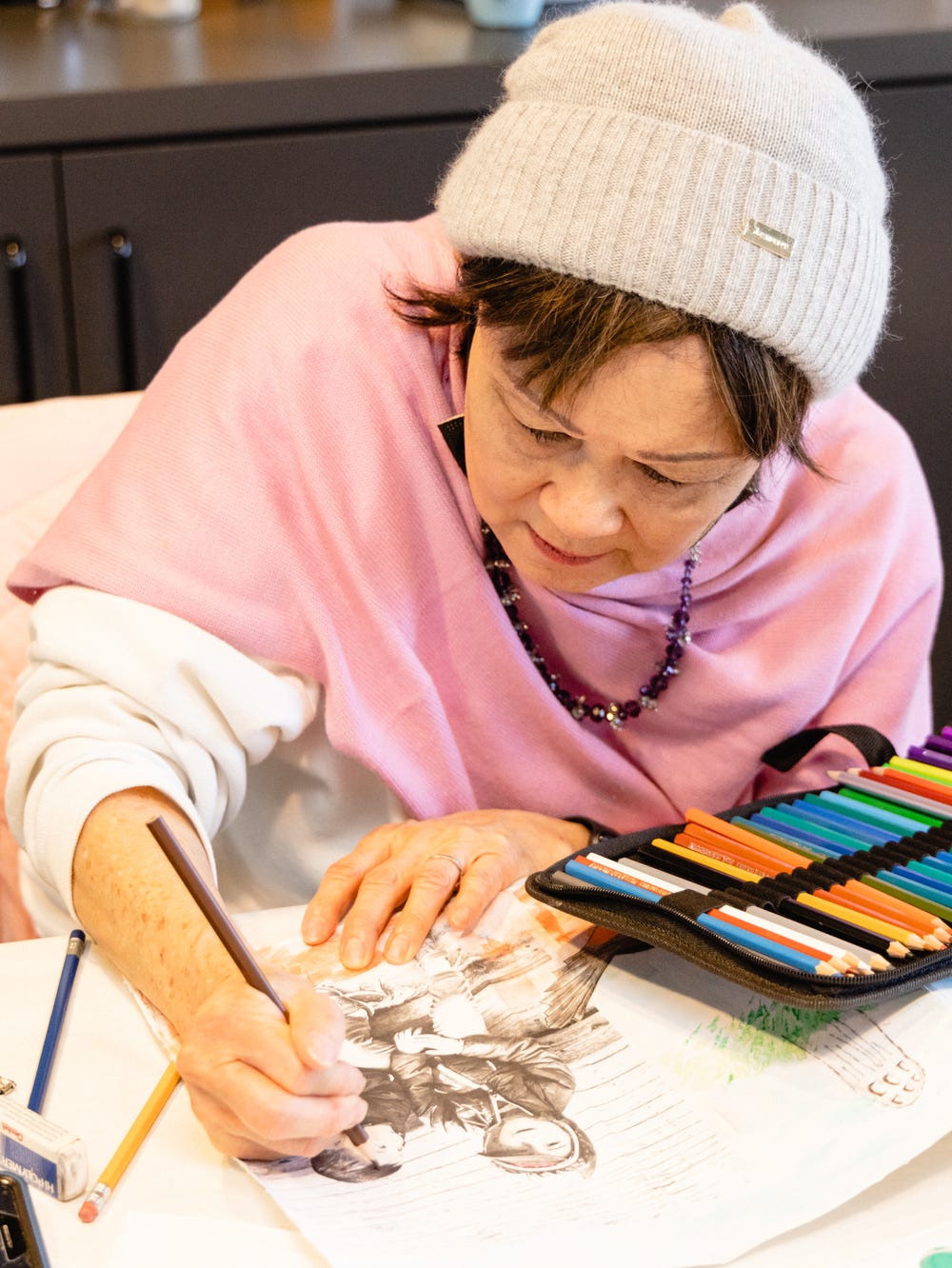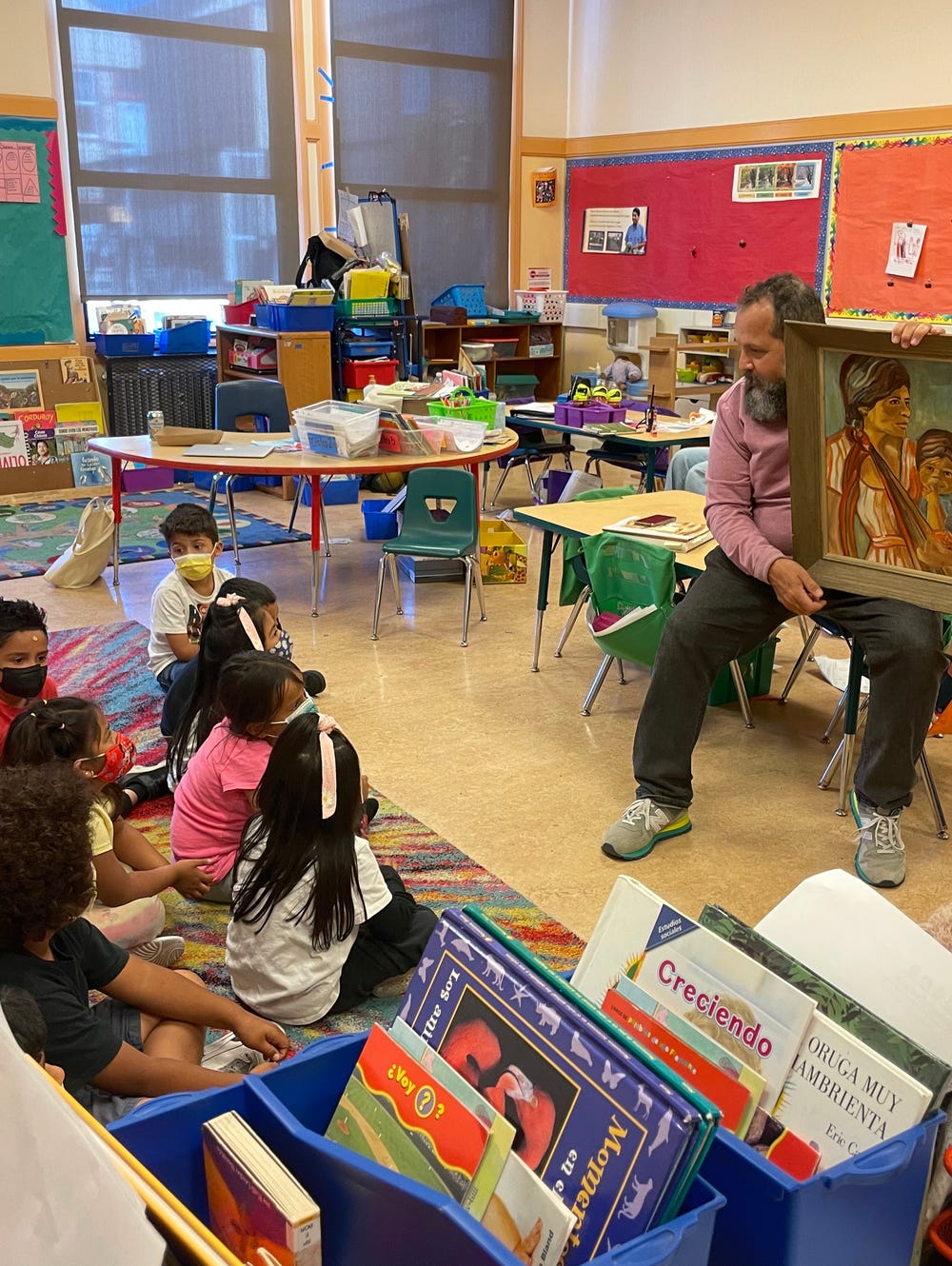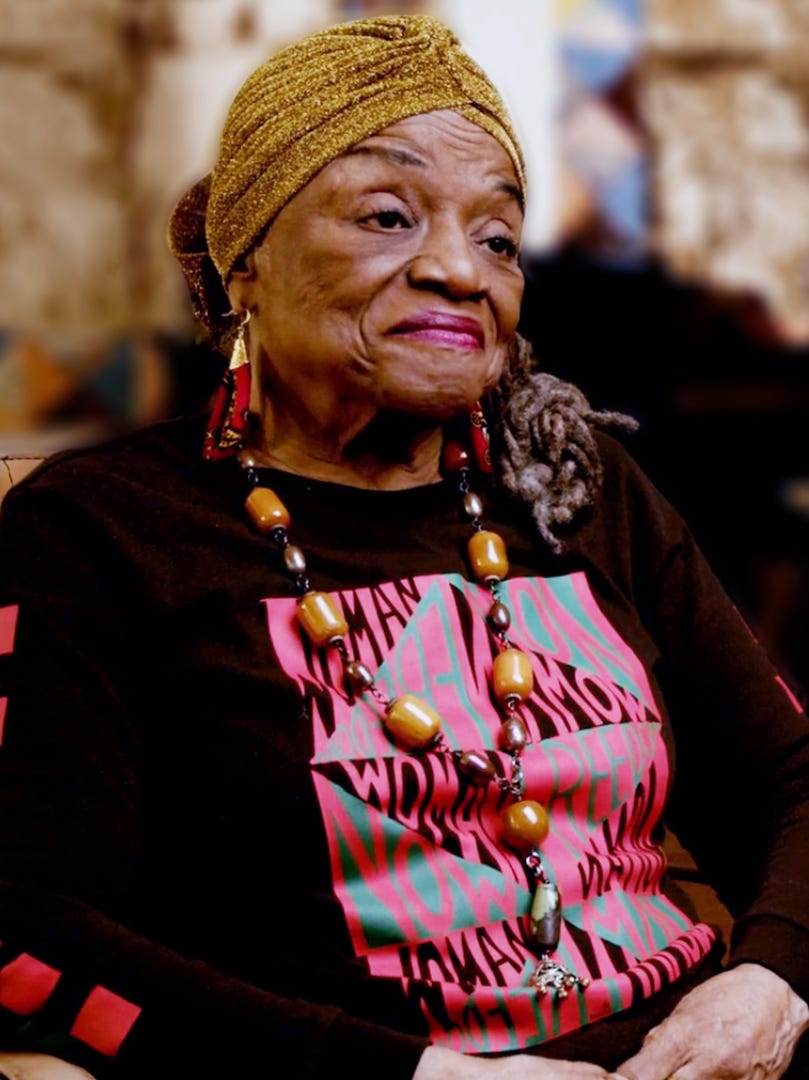Summer Camp at the de Young: Building Community + Equity
By Adrianna Alvarez and Emily Jennings
October 7, 2022
This summer, through a collaboration with the San Francisco Recreation and Park Department, we welcomed 750 campers from 15 SF Rec and Park sites across San Francisco to the de Young museum. The partnership provided an expanded opportunity to meet the needs of multiple communities across the city.
Since 2010, summer at the de Young museum has included welcoming streams of blue t-shirted campers to our galleries, studios, and outdoor spaces to talk about and make art. Through 2019, the Summer Art Camp was structured as a fee-based program that welcomed around 350 campers a year to work with our team of teaching artists and studio assistants. The process-based curriculum supported experimentation, exploration, and community building over the course of one week.
Though successful, the program had room for growth, particularly expanding the socioeconomic and racial diversity of the families who could participate. Lack of transportation for families from across the city limited the accessibility of the program. To increase greater socioeconomic diversity, from 2012 to 2019 we offered scholarships. We first partnered with teachers to identify students who might need financial assistance and later introduced a need-based scholarship application. While these efforts had an impact, we were aware that our systems fell short of identifying and meeting the financial needs of many students.
Faced with the pandemic, we first pivoted our summer program to a digital offering. However, with the museums’ commitment to anti-racist actions and our return to in-person programming, we wanted to completely rethink the program to make it more equitable and inclusive. To achieve this aim, our School and Family staff drew upon the structure of our newest school program, the Equity School Partnership Project (ESPP). This project provides resources to collaborate with youth, educators, and community-based organizations in historically underserved neighborhoods.
Working as part of a community partnership instead of internally, we created the space to collaborate with SF Rec and Park. We hosted four to five camps per week over nine weeks. During this period, campers experienced daylong visits to the de Young that included guided tours and studio activities.
Removing barriers, reaching out
The collaboration proved to be an exciting opportunity to introduce more local youth to the de Young and other cultural resources in Golden Gate Park. By partnering with SF Rec and Park, we were able to eliminate transportation and financial barriers that exclude many youth and families from equity zones throughout the city. Equity zones are identified through city data and include neighborhoods such as Bayview–Hunters Point, Visitacion Valley, and the Mission/Excelsior. With funding from San Francisco Parks Alliance, campers were transported to the Music Concourse in front of the de Young. Here, they rode the SkyStar Wheel, learned directly from artist Dana King about the meaning and significance of her artwork Monumental Reckoning, and explored the Japanese Tea Garden.
During visits to the museum, campers and staff participated in art lessons and guided conversations in the museum galleries with our educational team. Our educational team at the museum includes teaching artists, who are practicing artists within the community, and interpretation and outreach associates (IOAs), who are emerging art professionals from diverse backgrounds. Under staff guidance, campers explored the themes of color, nature, clay, and art and activism, as well as work by Bay Area artists, such as Ruth Asawa. Campers made observational drawings of Asawa's sculptures in the Education Tower and created their own color prints inspired by her work, experimenting with lines, shapes, as well as mark making and had fun exploring the printing process. Campers and staff also viewed special exhibits, such as The Obama Portraits Tour and Faith Ringgold: American People. During a final visit to the museum, one camp created a community quilt inspired by Faith Ringgold with memories from their summer with SF Rec and Park and at the museum. To increase access to the museum, each camper received a Passport to Golden Gate Park, which provides general museum entry for campers and their families through the end of the year.
While we always listen carefully to youth visiting the museum, our feedback has largely been filtered through the perspectives of supporting adults. This summer we listened directly to campers’ reflections about their experiences at the museum. Through various surveys, we invited campers to use words or pictures to express what they discovered, what they wanted to try, or what they enjoyed about their time in the galleries. Survey prompts and reflections included:
- Something I discovered while making art today
Even if you design something to be looked at at one angle, it still looks good at another. - Something new I learned today was
That it is important to find new ways of having fun. - How do you feel now and why?
I am now feeling excited and curious about clay.
These responses capture the sense of self-discovery, curiosity, and capacity for experimentation we aim for in our process-based approach. Collecting camper feedback also helped our team realize the time needed to solicit reflections in a meaningful way and the need for varied approaches that don’t rely solely on written responses. The use of drawings and camper quotes may serve as additional tools for the future.
Outreach, listening, and leaning into community strengths, needs, and interests have become essential to our partnership process. Frameworks of culturally responsive teaching, trauma-informed strategies, social-emotional learning, language accessibility (i.e., multilingual translation and staff), and centering the lived experiences and interests of youth continue to inform our teaching. Two larger questions remain:
- How do we build sustainable models around transportation for youth, families, and schools?
- How do we build sustainable models of outreach in which we move outside of the museum walls to build authentic and reciprocal relationships with Bay Area communities?
Looking ahead
Our work this past summer revealed many areas we want to refine and develop. These opportunities touch on every aspect of the program, ranging from the micro — printed material for campers to share with family members and caregivers — to the macro — reconsidering how time is allocated for trust building and engagement with youth. The areas we are currently prioritizing include maintaining relationships, increasing alignment, blending camp models, and investing in internal professional development.
- Maintaining relationships: This summer we worked with SF Rec and Park camp leads over multiple visits. This process laid the foundation for ongoing program development rooted in curriculum that builds on prior knowledge, interests, and experiences of local youth. Debriefing with partners is a key aspect of identifying future curriculum and multiple touchpoints for participating youth, either through their schools or on-site/off-site family programming.
- Increasing alignment: Through their work this summer, museum staff developed a rapport with many Rec and Park camp leads. As we look to next summer, we hope to work with Rec and Park staff during the program training period, as well. This will allow for relationship building, sharing of curriculum, and clarification of roles during the campers’ visits. It will also deepen shared approaches used with youth, such as trauma-informed strategies.
- Blending camp models: We engaged with 750 campers this summer — 400 more compared with previous years. While expanding our capacity was a positive development, it decreased our ability to build individual relationships with youth. In order to expand capacity while also building robust collaborations, we are looking at how we can blend models of off-site, on-site, and week-long offerings.
- Internal professional development: Our partnership with SF Rec and Park opened new professional development opportunities for our staff, including sessions about supporting English language learners, socially inclusive programming, healing-centered engagement, as well as trauma development and the brain. We need to sustain these efforts, with a focus on developing bilingual teaching and inclusion strategies for campers with unique developmental needs.
Concluding thoughts
Through our partnership with SF Rec and Park and ongoing work with ESPP, we hope to build on what we have learned this summer by continuing to break down transportation and financial barriers. There are opportunities for ongoing, sustainable relationship building and collaboration with the SF Rec and Park sites and school communities we have worked with thus far. In our efforts toward outreach and creating equitable and qualitative approaches to future partnerships, we are centering relationships, collaboration, and communication. Our commitment to creating relevant and equitable museum experiences for these school and community partnerships includes customized curriculum that builds on prior knowledge, interests, and experiences. It also addresses the need for translation support specific to visiting groups.
Actively engaging with Bay Area communities (i.e. listening and learning from them, including youth voices) allows us to re-envision our approach to future summer camp experiences as well as school and community partnerships. With equity and accessibility in mind, we are looking to alternative learning and accessible gathering spaces, while partnering with local community artists and arts-based organizations. In this way, we can continue to support youth, families, and schools by offering a safe space for learning, exchange of ideas and resources, and creative sharing and expression — both inside and outside of the museum.
Text by Adrianna Alvarez, manager of school and family partnerships, and Emily Jennings, director of school and family programs. Photographs by James Watkins, San Francisco Recreation and Park Department.
